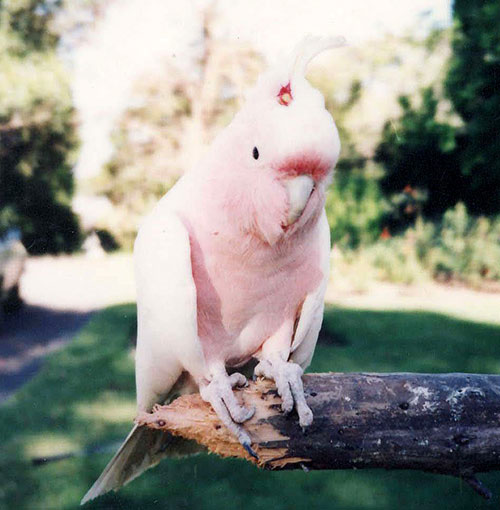In the late 1980s, the oldest resident of The Cottage in the grounds of Government House, Melbourne, was Cocky McGrath, an ancient Major Mitchell cockatoo (Lophochroa leadbeateri). Cocky was born in about 1908, and died from natural causes in 1994 – toppling quite suddenly from the branch of a rose tree. He was roughly 86. Cocky McGrath could speak three phrases very clearly and loudly: "Marg-aret!” (invariably when the phone rang), “Cocky’s got a cold!” and “Get out!” By the time I knew him slightly, no-one remembered who taught Cocky or why.
On one occasion Cocky McGrath withdrew for three weeks up a fir tree. There was some concern lest he became dehydrated, but Hugh Wirth, the Government House vet, reassured those nearest Cocky that he could extract all the moisture he needed by pecking at the fir cones. At length Cocky descended and, waddling purposefully down the long gravel drive, a vision in pink, came face to face with The Duke of Edinburgh, whose car was just then entering by the front gate. The Duke had his driver stop the car so as to get a better look at this extraordinary bird, whereupon Cocky McGrath squawked “Get out!”
News of Cocky’s demise reached the Royal Yacht Britannia in Jamaican waters. A message of condolence was soon afterwards received from The Queen and the Royal Household, including Cocky’s kinsman Sir Brian McGrath, who was at that time the Duke of Edinburgh’s private secretary. It seems likely that Cocky McGrath was the only Major Mitchell cockatoo (or any other kind) ever to be so acknowledged by his sovereign.
The Cottage, actually a fairly substantial weatherboard house, was originally built during World War I, or shortly afterwards, to accommodate the military secretary to the governor-general. Major the Lord Digby (1894–1964), who occupied that position from 1920 to 1923 when Cocky McGrath was a young bird, brought Lady Digby and their children to live in The Cottage. The Hon. Pamela Digby Churchill Hayward Harriman, the Digbys’ eldest daughter, had vivid recollections of having lived there as a child, and shared these with Charles Curwen when, in 1978, she returned to Melbourne with her third husband, Ambassador W. Averell Harriman, who represented the United States Congress at the funeral of Sir Robert Menzies. Happily reunited with Mrs Harriman, Cocky McGrath nevertheless strained matters by squawking “Get out!”
Soon after the end of World War II, when the King’s younger brother, Prince Henry, Duke of Gloucester, served briefly as governor-general, the Princes William and Richard of Gloucester (the present duke) and their household lived on the grounds of Government House in Melbourne, and not at Yarralumla or Admiralty House in Sydney. The ground floor of The Cottage was extended to accommodate them. By this time Cocky McGrath was a middle-aged bird who had witnessed all these and many other developments. As a longstanding member of successive vice-regal households, however, Cocky McGrath was ever the soul of discretion.
The identity of Margaret, meanwhile, has never been established with certainty.














